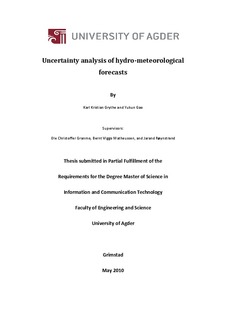| dc.description.abstract | Meteorological and hydrological forecasts are very important to human’s life which concerns
agriculture, industry, transport, etc. The Nordic hydropower industry use and develop
hydrological forecasting models to make predictions of rivers steam flow. The quantity of
incoming stream flow is important to the electricity production because excessive water in
reservoir will cause flood and the loss of hydropower energy. Therefore the accurate
prediction will help the managers decide the optimal production level in the reservoir at the
current time. If for instance the predicted runoff exceeds the limit of water that the plant
can process, then it is possible to increase production early so the water level does not get
higher than the edge of the reservoir.
In our project, we are studying the uncertainties which come from both meteorological and
hydrological forecasting systems, and propose a new error correction methodology to
reduce the uncertainties in the forecasted runoff.
We study the uncertainties in the meteorological data, and then evaluate the accuracy of
the meteorological data. Then we feed the meteorological data into a hydrological
forecasting system, called the “OHBV model” with forecasted meteorological data. Later we
run the model again with observed meteorological data. By running the model twice with
different input we evaluate the performance of the OHBV model, and find the level of
improvement expected when having a more accurate weather forecast. The OHBV model is
also referred to as “OHBV” for short.
At last we focus on error correction that are algorithms used to improve the runoff forecast
based on statistics. We test the existing error correction method, called the “Powel
algorithm”, and we identify how much of the error it could reduce. The error reduction is
found by comparing the runoff forecast with the observation of stream flow runoff.
Furthermore, we propose our own error correction method, referred to as “Yukun&Karl
algorithm”, and finally evaluate the performance of the new method.
Our results show that the main part of the error comes from the HBV model in the first
forecast, while when using observation data as input into the model the output improves
most for last days where the weather forecasts have higher uncertainty. Weather forecasts
have errors, but have gone through much refinement the latest years, and until the HBV
model performs better, this is not where the main focus should be. Since the OHBV model
give high errors even in the prediction with the least of uncertainty (in the 1 day ahead in
forecast), this should be investigated and improved.
Error correction algorithms are applied after the model itself, and are used to give an overall
improvement, though it sometimes can make the individual error larger. The best
improvement by correction is in the “1 day ahead “runoff forecast, but after 4-5 days the
Powel correction generally causes more errors than it can correct. The developed
“Yukun&Karl algorithm” works up until the 8th day. The error corrections algorithms counter
some of the effects from the simplification of hydrological systems in the OHBV model, but
error correction is only based on the statistics of the input forecast. Error correction is a quick and relative simple way to improve the forecast, but as any “quick fix” it has its
limitations, and can only improve forecasts some. The findings can result in further
development of error correction and improve the prediction of runoff. Error correction can
also be used in other fields, as long as the data used have statistical probabilities that can be
exploited | en_US |
